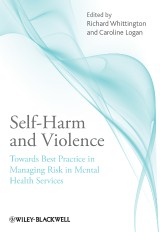Details

Self-Harm and Violence
Towards Best Practice in Managing Risk in Mental Health Services1. Aufl.
|
44,99 € |
|
| Verlag: | Wiley |
| Format: | EPUB |
| Veröffentl.: | 16.03.2011 |
| ISBN/EAN: | 9781119996224 |
| Sprache: | englisch |
| Anzahl Seiten: | 336 |
DRM-geschütztes eBook, Sie benötigen z.B. Adobe Digital Editions und eine Adobe ID zum Lesen.
Beschreibungen
<i>Self-Harm and Violence: Towards Best Practice in Managing Risk in Mental Health Services</i> presents the first exploration of the most effective clinical practice techniques relating to the management of risk in mental health care settings. <ul> <li>Based on the Department of Health’s <i>Best Practice in Managing Risk</i> guidance document, which was developed over a 12-month period in consultation with a national expert advisory group</li> <li>Features contributions from many members of the group that drew up the <i>Best Practice</i> document – all leading theoreticians and practitioners in their particular fields – and embeds the principles laid out in the guidelines in real world practice</li> <li>Reveals how contemporary risk management is a multidisciplinary and collaborative enterprise in which practitioners from different professions need to engage with each other in order to achieve success</li> </ul>
Contributors. <p>Foreword.</p> <p>Preface.</p> <p>1 Introduction (<i>Richard Whittington and Caroline Logan</i>).</p> <p><b>PART I EXPERIENCE.</b></p> <p>2 Service Users: Experiences of Risk and RiskManagement (<i>Kay Sheldon</i>).</p> <p>3 Carers: Experiences of Risk and RiskManagement (<i>Sally Luxton</i>).</p> <p><b>PART II EVIDENCE.</b></p> <p>4 Understanding andManaging Self-HarminMental Health Services (<i>Maria Leitner and Wally Barr</i>).</p> <p>5 Understanding andManaging Violence inMental Health Services (<i>Richard Whittington, James McGuire, Tilman Steinert and Beverley Quinn</i>).</p> <p>6 Suicide and Homicide by People withMental Illness: A National Overview (<i>Kirsten Windfuhr and Nicola Swinson</i>).</p> <p>7 Evidence and Principles for Service User Involvement in RiskManagement (<i>Helen Gilburt</i>).</p> <p><b>PART III PRACTICE.</b></p> <p>8 Guidelines and Standards forManaging Risk inMental Health Services (<i>Caroline Logan, Norbert Nedopil and Thomas Wolf</i>).</p> <p>9 Organizations, Corporate Governance and RiskManagement (<i>Ben Thomas</i>).</p> <p>10 Formulation in Clinical Risk Assessment andManagement (<i>Caroline Logan, Rajan Nathan and Andrew Brown</i>).</p> <p>11 Evidence and Principles for Positive RiskManagement (<i>Paul Clifford</i>).</p> <p>12 Encouraging Positive RiskManagement: Supporting Decisions by People with Learning Disabilities Using a Human Rights-Based Approach (<i>Richard Whitehead, Ged Carney and Beth Greenhill</i>).</p> <p><b>PART IV IMPLEMENTATION.</b></p> <p>13 Case Study 1: A Four-StepModel of Implementation (<i>Geraldine Strathdee, Phil Garnham, Jane Moore and Devendra Hansjee</i>).</p> <p>14 Case Study 2: Narrowing the Gap between Policy and Practice (<i>Kate Hunt</i>).</p> <p>15 Case Study 3: Learning fromExperience – Using Clinical Risk Data to Influence and Shape Clinical Services (<i>Louise Fountain and Patrick McKee</i>).</p> <p>16 Case Study 4: FromTicking Boxes to Effective RiskManagement (<i>Lorna Jellicoe-Jones, Mark Love, Roy Butterworth and Claire Riding</i>).</p> <p>17 Conclusions (<i>Caroline Logan and Richard Whittington</i>).</p> <p>Glossary.</p> <p>Index.</p>
<b>Richard Whittington</b> is Professor of Mental Health in the <st1:PlaceType w:st="on">School</st1:PlaceType> of <st1:PlaceName w:st="on">Health Sciences</st1:PlaceName> at the <st1:place w:st="on"><st1:PlaceType w:st="on">University</st1:PlaceType> of <st1:PlaceName w:st="on">Liverpool</st1:PlaceName></st1:place> and an Honorary Research Fellow at Mersey Care NHS Trust. He has a PhD from the <st1:PlaceType w:st="on">Institute</st1:PlaceType> of <st1:PlaceName w:st="on">Psychiatry</st1:PlaceName> in <st1:place w:st="on"><st1:City w:st="on">London</st1:City></st1:place>, and is a researcher and forensic psychologist with a particular research interest in the issues of violence, self-harm and mental health. <p/> <b>Caroline Logan</b> is a Consultant Forensic Clinical Psychologist in Greater Manchester West Mental Health NHS Foundation Trust and an Honorary Research Fellow at the <st1:PlaceType w:st="on"><st1:place w:st="on"><st1:PlaceName w:st="on">University</st1:PlaceName></st1:place> of <st1:PlaceName w:st="on">Manchester</st1:PlaceName></st1:PlaceType>. She has a DPhil from the <st1:PlaceType w:st="on"><st1:place w:st="on">University</st1:place> of <st1:PlaceName w:st="on">Oxford</st1:PlaceName></st1:PlaceType> and is both practitioner and researcher, focusing on violence and self-harm, personality disorder and risk.
The unique challenges faced by mental health service workers who engage with patients exhibiting violent or self-harmful behaviour is a growing concern. Service-users and practitioners exposed to these types of behaviours are often themselves the sufferers of anxiety, misery, and serious injury. Providers and commissioners alike have a shared interest in working more effectively to resolve this increasingly complex issue. <p><i>Self-Harm and Violence: Towards Best Practice in Managing Risk in Mental Health Services</i> sets out for the first time to examine and explore the most effective clinical practice techniques relating to the management of risk in mental health care settings. The volume’s contributors, many of whom were members of the original national advisory group which drew up the Department of Health’s 2007 <i>Best Practice in Managing Risk</i> guidelines, are all leading experts in their respective fields. The implementation of <i>Best Practice</i> into a variety of 'real world' clinical settings sheds important new light on the effectiveness of various risk management techniques.</p> <p><i>Self-Harm and Violence</i> represents a state-of-the-art assessment of our knowledge and understanding of best practice in the management of risk in mental health care settings.</p>
<i>Self-harm and Violence: Towards Best Practices in Managing Risk in Mental Health Services</i> fills an important gap in the literature, presenting the voice of service users, summarizing the latest research about the risk of harm to self or others, and reviewing the strength of evidence for interventions used to prevent or reduce risk and harm on inpatient psychiatric units. This scholarly, yet highly accessible book will appeal to academics who are interested in studying issues related to harm to self or others, nursing staff who manage risk on a day-to-day basis, and educators who will welcome the compilation of information in one source. <br /> —<b><i>Mary E. Johnson</i></b><i>, Professor of Nursing, Rush University, Chicago, USA</i>
Diese Produkte könnten Sie auch interessieren:

Boysya, ya s toboy 2. Strashnaya kniga o rokovyh i neotrazimyh. I eto vse o nih

von: Tanya Tank

6,99 €















